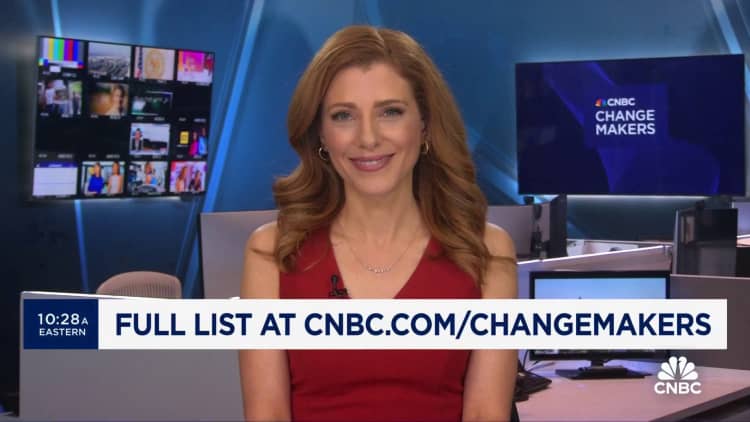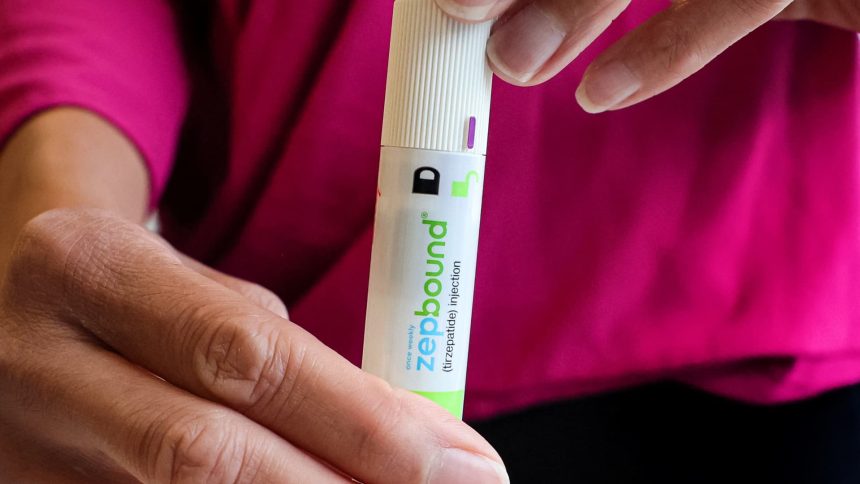For all of the promise associated with new weight loss drugs such as Novo Nordisk‘s Wegovy and Eli Lilly‘s Zepbound in treating obesity, there’s a very big risk printed right on the label at the requirement of the FDA: patients should be prescribed these so-called GLP-1 drugs only in combination with, not as a replacement for, diet and exercise programs.
The boom in these drugs — with more poised to enter the pharmacy market and the employer-based insurers still in the early days of adding coverage for workers — is just getting started. Does that make it the greatest opportunity a diminished WeightWatchers has seen in a long time to reinvigorate its business model, or an existential threat unlike any it has faced in its history as obesity is treated more like a chronic disease requiring medicine?
When WW CEO Sima Sistani — who was named to the inaugural CNBC Changemakers list on Wednesday — made the acquisition of Sequence, now WeightWatchers Clinic, last March to get the company into the clinicals business, she made a move that the company needed.
More from CNBC Changemakers
Even Wall Street analysts skeptical of WW’s stock chart and a market cap that is currently dwarfed by outstanding debt roughly five times its valuation — though not coming due for several years yet — agree that Sistani pulled the trigger at the right time on the right kind of business. Having a link to the weight-loss drug prescription market is a must. But will Americans trust the most iconic brand in the legacy weight-loss business to guide them into its future?
“I’ve been covering WW for about ten years and there has never been anything like this,” said Alex Fuhrman, an analyst at Craig-Hallum. “It’s all unfolding in real time.”
Some of the real-time action has been decidedly negative. Recent results from companies in the nutrition and diet space have been ugly, from Herbalife to Medifast, declines that analysts say may have more than one cause, and reflect multiple business models, but taken together, cannot be separated from the weight-loss drug phenomenon.
“I think it was a smart acquisition for them to make,” Fuhrman said in a recent interview. “Big pharma was coming for weight loss, and if they didn’t have a clinical angle, they would have run the risk of becoming an irrelevant company.”
The initial excitement associated with the Sequence deal, which boosted shares of WW above $10 by the summer, quickly wore off, with the stock losing two-thirds of its value since late August. In the weeks ahead of WW’s earnings report — the company released its latest quarterly numbers and outlook after the close on Wednesday — sentiment had mostly stayed negative, though it’s a volatile stock due to its debt load on any given day.
For sure, this was the most important quarterly reporting periods of the year for companies in the weight management sector, with management teams providing commentary on the key post-holidays period, seasonally the strongest. The whispers on Wall Street were all bearish, mostly due to analysis of online data used to make a best guess at recent consumer interest and sales. In a typical year, WW acquires up to 40% of customers in the first quarter.
“The web traffic data got noisy, all of a sudden app download data got negative,” said D.A. Davidson analyst Linda Bolton Weiser in an interview ahead of the earnings.
Fuhrman said some investors got carried away over the summer, with the expectation that the Sequence deal would cause a dramatic inflection higher in earnings as soon as this year. But from all of the data that has come out lately, “it looks like interest in traditional diet companies is down pretty significantly,” he said.
The demand curve is not just a WW issue.
Digital app rival Noom, like WW, has entered the clinicals space, launching Noom Med last May. “I’ve said in an all-hands meeting at the company that similar to the first iPhone, there was life before and after it. It has a gravity all to itself,” said Noom CEO Geoff Cook. “This is a new, incredibly powerful and effective class of pharmaceuticals that a lot of people will find help improve their health.”
Serving as a companion program to a percentage of the GLP-1 prescriptions to be written in the U.S. and globally is a “massive opportunity,” Cook said. “Most people still don’t know what GLP-1 is, but they will. But we cannot be in an age where we just say ‘give yourself a drug and be done.'”
Risks of overreliance on obesity drugs
The risk is real that providers may use the medications and “forget about lifestyle,” said John Batsis, an associate professor and nutrition expert at the University of North Carolina Chapel Hill’s school of public health. And in certain populations, that will compound the risk among patients for potential malnutrition, loss of muscle mass, or bone [density], too, among other potential adverse events.
“I am a firm believer that persons with obesity should really have a lifestyle-based program,” Batsis said.
Using bariatric surgery as an example, the research shows that those patients who undergo the procedure and engage in a lifestyle-based program do better than those that just have the surgery.
“I suspect the same will happen with these new medications,” Batsis said. “The research, however, is scant at best with the combination of lifestyle plus these newer medications. We certainly need more to understand these gaps in the science.”

Right now, given the cost of the drugs, from $1,000 to $1,500 a month without discounts or insurance coverage, many people are turning to significantly cheaper compounded semaglutides with the same chemistry as new drugs, which are often allowed to stay on the market when brand-name drugs proven to have medical value are in short supply.
D.A. Davidson’s Bolton Weiser is among this demographic. “I bought compounded online, they’re doing lots of business. I wanted to pay $250 a month, not $1,000,” she said, and she added that her initial experience points to the value of professional guidance. While she didn’t have to speak to a clinician to order the compounded supply, “I would rather have had a clinician for the one or two times I started vomiting,” Bolton Weiser said. “Lots of people are very scared about the drugs, and I think WW is a world expert and they have the most trusted brand.”
“No medication will teach you how to eat healthier or ensure you get enough protein and fiber. Medication alone will also not help you with resistance training to preserve muscle mass,” Dr. Amy Meister, WeightWatchers chief medical officer, told CNBC via email on Monday.
Ensuring that a patient gets a high protein diet, including the use of protein tracking tools, and engaging in the right muscle-building exercises and resistance training to preserve lean muscle mass, are both important to lessen the risk that the drug causes the bodily damage that Batsis outlined. There’s also the unknowns related to how long to stay on these drugs, and how to moderate dosages, with early studies showing that weight gain can return when patients go off the medication.
“Once you hit the target weight, you have to figure it out,” Bolton Weiser said. “I lost 10 pounds and I want to lose 15, and then what do I do?”
With obesity to be treated as a chronic disease, the question going forward, according to Batsis, is this: “Can we scale back the dose, can the dosing regimen change, and/or can we engage in lifestyle modifications to maintain a degree of weight loss? We don’t know what that ‘sweet spot’ is just yet.”

‘Forever meds’
“There will always be a considerable cohort that is not okay with a forever med,” Cook said, but he added that the data on how long it takes for patients to reach peak weight loss using the drugs before behavioral modifications should be prioritized remains preliminary — though he did say Noom has data from a one-year study it did with a pharmaceutical company (not published or peer reviewed yet) which did show greater weight loss and greater adherence to weight management when behavioral modification was included in the program.
WeightWatchers is currently investigating what characteristics may predict if a person could “de-escalate” off medications. Meister cited a recent study published by Epic Healthcare’s research department on over 20,000 patients who took a GLP-1 and lost at least 5 pounds, and then discontinued treatment. They found that around two-thirds of the patients kept their weight off after 18 months, but the study did not look at the presence or absence of lifestyle changes.
Batsis said the good news is that there is already four years of data from the main drug trials. But he added, “Do we know long-term effects? Not just yet. But it’s like any other medication we prescribed that comes onto the market. It’s a matter of weighing risks/benefits. There are major risks in persons with obesity in terms of their medical issues. So clinicians need to work carefully and closely with their patients to determine and balance some of these unknowns.”
That implies a considerable revenue opportunity for companies including WW and Noom if they can capture a sizable piece of the market connecting patients with clinicians and serving as the weight management bridge in between.
“Insurers have signaled, and there is belief among doctors, that it will be a step therapy approach,”
Bolton Weiser said, referring to the conditions that insurers can require before approving a prescription. “There is no way insurers can cover these drugs economically. They will require some sort of behavior modification and then offer reimbursements.”
The new psychology of weight loss
A monthly clinical subscription is worth roughly four times the core WW digital subscription in revenue per user, and relative to how much the drugs cost versus a $100 per month subscription, there’s a compelling incentive for the industry to steer people to WW, or a similar competitor, as a condition for prescription approval.
“In theory, it’s a new growth area, but do people really think they need these programs when on the drugs? That remains to be seen,” Fuhrman said. “The advice of the medical community is people should be very mindful of what they are eating and making sure they are getting protein and exercise when taking these drugs. Do people do those things? The jury is still out.”
Both WW and Noom, among others, are aggressively seeking to grow their business-to-business sales as insurance carriers and employer-sponsored plans look at adding coverage and requiring adoption of a behavioral modification plan for a prescription.
“The psychology of weight loss is completely different on GLP-1 drugs,” Cook said. “The mindset is not as important. You are going to lose weight. You don’t need to believe it, but the trick is to eat the right things and exercise and we’ve designed a whole curriculum around that. We will ramp you up and then the program adapts as you go off med.”
It’s still early days, and there is still the core business to consider, which has provided the majority of revenue to date. If the clinicals business for WW and Noom is a tailwind, it’s still much smaller than the size of the headwind they face in the legacy market. “With the expansion of GLP-1, it will grow nicely over the next few years, but if 90% is shrinking and only 10% growing, then it’s hard to show sustainable growth,” Fuhrman said of WW.
Bolton Weiser agrees with that point. “It doesn’t matter if it’s 100% growth in the next three years. It won’t become bigger than the core business and the core business has to grow. It can’t be a melting ice cube.”
She has a more bullish view of WW, noting it has barely done any advertising for the GLP-1 business given the drug shortages. “They are not going to do it wrong. They are in it for the long term. They don’t want to link up with a compounder,” she said.
In the same way Lilly or any other drug company sells to doctors in offices, the insurers and doctors need to recommend to patients weight management programs. “No. 1 in weight loss is WW. Sima [Sistani] is trying to figure it out for the long-term, given the market share advantage,” Bolton Weiser said.
But on Wednesday, when WW’s latest results hit, the company subscriber numbers may have seemed a little light. It ended Q4 with 3.8 million subscribers, including 67,000 for clinical subscriptions, but its guidance for the full year 2024 was total subscriber growth in the range of 3.8 million to 4.0 million, including between 140,000 and 160,000 subscribers to WeightWatchers Clinic.
Issued alongside the results, there was a message from another trusted brand that may have helped sink WW stock even more at a time when it needs a vote of confidence. It was not consumers walking away en masse from traditional weight management programs. It was the departure of an icon as associated with weight challenges as WW itself, and as trusted as a brand gets with the American public.
Oprah Winfrey — who had joined the company program, acquired a significant stake and also become a board member in 2015 — announced she was leaving the executive position in May and donating her shares to the National Museum of African American History and Culture. Shares were down by as much as 25% in trading after the news.
Winfrey said in a statement she will continue to advise and collaborate with WeightWatchers and CEO Sima Sistani in “elevating the conversation around recognizing obesity as a chronic condition, working to reduce stigma, and advocating for health equity.”
Read the full article here




